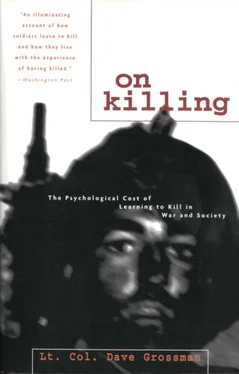Another excellent example of soldiers exercising their right to miss is this mercenary-journalist’s account of going with one of Eden Pastora’s (a.k.a. Commandante Zero) Contra units on an ambush of a civilian river launch in Nicaragua:
I’ll never forget Surdo’s words as he gave his imitation of a Pastora harangue prior to going into battle, telling the entire formation, “ Si mata una mujer, mata una pirícuaco; si mata un niño, mata un pirícuaco. ” Pirícuaco is a derogatory term, meaning rabid dog, we used for the Sandinistas, so in effect Surdo was saying “If you kill a woman, you’re killing a Sandinista, if you kill a child, you’re killing a Sandinista.” And off we went to kill women and children.
Once again I was part of the 10 men who would actually perform the ambush. We cleared our fields of fire and settled back to await the arrival of women and children and whatever other civilian passengers there might be on this launch.
Each man was alone with his thoughts. Not a word was spoken among us regarding the nature of our mission. Surdo paced back and forth nervously some yards behind us in the protection of the jungle.
…The loud throb of the powerful diesels of the 70-foot launch preceded its arrival by a good two minutes. The signal to commence firing was given as it appeared in front of us and I watched the RPG-7 [rocket] arc over the boat and into the jungle on the opposite bank. The M60 [machine gun] opened up, I rattled off a 20-round burst from my FAL. Brass was flying as thick as the jungle insects as our squad emptied their magazines. Every bullet sailed harmlessly over the civilian craft.
When Surdo realized what was happening he came running out of the jungle cursing violently in Spanish and firing his AK [rifle] at the disappearing launch. Nicaraguan peasants are mean bastards, and tough soldiers. But they’re not murderers. I laughed aloud in relief and pride as we packed up and prepared to move out.
— Dr. John “American in ARDE”
Note the nature of such a “conspiracy to miss.” Without a word being spoken, every soldier who was obliged and trained to fire reverted — as millions of others must have over the centuries — to the simple artifice of soldierly incompetence. And like the firing-squad member mentioned earlier, these soldiers took a great and private pleasure in outmaneuvering those who would make them do that which they would not.
* * *
Even more remarkable than instances of posturing, and equally indisputable, is the fact that a significant number of soldiers in combat elect not even to fire over the enemy’s head, but instead do not fire at all. In this respect their actions very much resemble the actions of those members of the animal kingdom who “submit” passively to the aggression and determination of their opponent rather than fleeing, fighting, or posturing.
We have previously observed General S. L. A. Marshall’s findings concerning the 15 to 20 percent firing rates of U.S. soldiers in World War II. Both Marshall and Dyer note that the dispersion of the modern battlefield was probably a major factor in this low firing rate, and dispersion is indeed one factor in a complex equation of restraints and enabling mechanisms. Yet Marshall noted that even in situations where there were several riflemen together in a position facing an advancing enemy, only one was likely to fire while the others would tend to such “vital” tasks as running messages, providing ammo, tending wounded, and spotting targets. Marshall makes it clear that in most cases the firers were aware of the large body of nonfirers around them. The inaction of these passive individuals did not seem to have a demoralizing effect on actual firers. To the contrary, the presence of the nonfirers seemed to enable the firers to keep going. [5] This is an important concept. In both this section and in later sections we will observe the vital role of groups (including nonkillers) and leaders as we look at “An Anatomy of Killing.”
Dyer argues that all other forces on the World War II battlefield must have had somewhere near the same rate of nonfirers. If, says Dyer, “a higher proportion of Japanese or Germans had been willing to kill, then the volume of fire they actually managed to produce would have been three, four, or five times greater than a similar number of Americans — and it wasn’t.” [6] Marshall also observed that if a leader came close to an individual and ordered him to fire, then he would do so, but as soon as the obedience-demanding authority departed, the firing would stop. However, the focus in this section is upon the average soldier armed with a rifle or musket and his apparent unwillingness to kill in combat. The impact of obedience-demanding authority and the effect of group processes on crew-served weapons, i.e., machine guns, which almost always fire, and key weapons (i.e., flamethrowers and automatic rifles), which usually fire, are both addressed in “An Anatomy of Killing.”
There is ample supporting evidence to indicate that Marshall’s observations are applicable not only to U.S. soldiers or even to the soldiers on all sides in World War II. Indeed, there are compelling data that indicate that this singular lack of enthusiasm for killing one’s fellow man has existed throughout military history.
A 1986 study by the British Defense Operational Analysis Establishment’s field studies division used historical studies of more than one hundred nineteenth- and twentieth-century battles and test trials using pulsed laser weapons to determine the killing effectiveness of these historical units. The analysis was designed (among other things) to determine if Marshall’s nonfirer figures were correct in other, earlier wars. A comparison of historical combat performances with the performance of their test subjects (who were not killing with their weapons and were not in any physical danger from the “enemy”) determined that the killing potential in these circumstances was much greater than the actual historical casualty rates. The researchers’ conclusions openly supported Marshall’s findings, pointing to “unwillingness to take part [in combat] as the main factor” that kept the actual historical killing rates significantly below the laser trial levels.
But we don’t need laser test trials and battle reenactments to determine that many soldiers have been unwilling to take part in combat. The evidence has been there all along if we had only looked.
CHAPTER TWO
Nonfirers Throughout History
Nonfirers in the Civil War
Imagine a new recruit in the American Civil War.
Regardless of the side he was on, or whether he came in as a draftee or a volunteer, his training would have consisted of mind-numbingly-repetitive drill. Whatever time was available to teach even the rawest recruit was spent endlessly repeating the loading drill, and for any veteran of even a few weeks, loading and firing a musket became an act that could be completed without thinking.
The leaders envisioned combat as consisting of great lines of men firing in unison. Their goal was to turn a soldier into a small cog in a machine that would stand and fire volley after volley at the enemy. Drill was their primary tool for ensuring that he would do his duty on the battlefield.
The concept of drill had its roots in the harsh lessons of military success on battlefields dating back to the Greek phalanx. Such drill was perfected by the Romans. Then, as firing drill, it was turned into a science by Frederick the Great and then mass-produced by Napoleon.
Today we understand the enormous power of drill to condition and program a soldier. J. Glenn Gray, in his book The Warriors, states that while soldiers may become exhausted and “enter into a dazed condition in which all sharpness of consciousness is lost” they can still “function like cells in a military organism, doing what is expected of them because it has become automatic.”
Читать дальше







